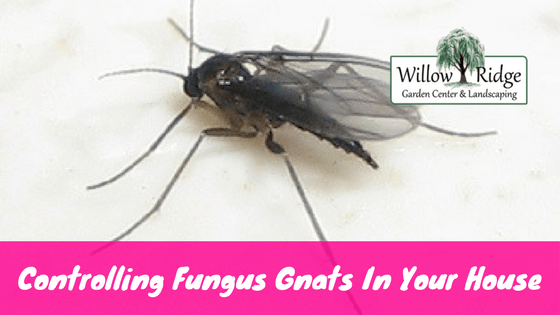Controlling Fungus Gnats in your Home
We get certain questions over and over each year. One of the most common is: Why do I have gnats or flies on my house plants? Or What are these little gnats or flies? The answer is usually Fungus Gnats, a small fly which lays eggs in moist soil, or soil rich in organic matter. Read on to find out more about controlling Fungus Gnats in your home.
Life Cycle
The adult or gnat lays eggs in moist soil that is high in organic matter. The eggs hatch into larvae in 3-4 days. The larvae are the biggest concern, because they are the ones that can harm your plants. The larvae are present for 7-10 days before they turn into a pupae. The pupae will turn into the gnat you see flying around 3-4 days later. In warm moist conditions the Fungus Gnat life cycle can go from start to finish in about 2 weeks, so you could have many generations each year.
The larval stage is the one that can do the most harm to your plants. The little worms feed on fungus and organic matter that is present in potting soil. They can also feed on the roots of your plants. Root damage will weaken the plant and can even lead to plant death if conditions aren’t improved.
Controlling Fungus Gnats
You can control Fungus Gnats by improving soil conditions, or by using chemical or biological control methods.
Fungus Gnats are most prolific in soil that stays too wet, either due to lack of drainage or soil compaction. These overly moist conditions with abundant organic matter such as dead leaves allow more fungus to be present and thus more food for the larvae.
Improving Soil Conditions
- You can repot the plant with new potting soil. You should use a processed soil that has been sterilized.
- Improve the drainage by making sure the soil is not compacted.
- Make sure that water can drain out of the pot into a saucer or reservoir that is not in contact with the soil. You can always put a layer of gravel or Styrofoam peanuts at the bottom of the container to get this separation.
- AVOID OVERWATERING – Allow the soil to dry out between waterings.
- Remove any dead leaves that fall onto the soil.
- Avoid using compost, manure or topsoil in indoor containers, they are high in organic matter and can already have larvae present.
Biological Controls
- You can introduce strains of Nematodes that will kill the larvae.
- Predatory mites can also be introduced that will feed on the larvae.
- A strain of bacteria called BT or Bacillus Thuringiensis will kill off the larvae, and is probably the easiest and most available form for home owners. It is available in liquid forms or granular (Mosquito Bits).
- Pyrethrin insecticides sprayed on the gnats or on the soil can give some quick results, but would need to be repeated.
Fungus Gnats are a nuisance and can be a danger to plants if left unchecked, but by following the steps above to improve the soil condition they can be avoided.

